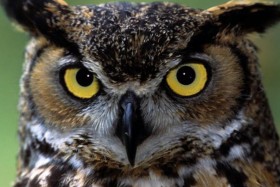 Students from Sawyer School got an early Halloween treat last week when they saw a Great Horned Owl at Crossroads. Actually, the students heard a mob of crows cawing wildly, and it was soon apparent that at least thirty crows were chasing one owl. The kids were surprised that owls could see in daylight. They can. But owls see amazingly well at night.
Students from Sawyer School got an early Halloween treat last week when they saw a Great Horned Owl at Crossroads. Actually, the students heard a mob of crows cawing wildly, and it was soon apparent that at least thirty crows were chasing one owl. The kids were surprised that owls could see in daylight. They can. But owls see amazingly well at night.
One student asked, “Will the owls have more hunting time after daylight savings time ends?”
Actually, they will, but not because we change our clocks. Nights just are getting longer this time of year.
Daylight Savings ends the Sunday after Halloween, and that won’t help the owls. No hours of darkness will be saved. And it won’t help the Door Peninsula Astronomical Society this month either, for they have scheduled their November Viewing Night for November 2—-the Saturday evening closest to the new moon.
In summer, it’s practically the middle of the night before it gets dark enough for night sky viewing, but even before we “fall back” on Sunday morning, it should be dark enough at 7:00 PM for the public outreach at the Leif Everson Observatory to begin provided the skies are clear. That can be a BIG IF in November.
Amateur astronomers and most species of owls need to see in the dark. Consequently, the eyes of owls, like astronomical equipment, must be very good at collecting and processing light.
Participants at the Viewing Night will notice that the openings at the ends of astronomical binoculars are very large—much larger than the openings on a pair of birding binoculars. The opening of the observatory telescope is huge. Owl eyes also are disproportionately large. That makes sense. The bigger the opening, the more light can be collected.
In an owl eye, the lens focuses an image onto the retina. That’s true of human eyes too, except that our retinas have cells called cones (which react to colors.) and rods (which react to light.) Owl eyes have a few cones, but mostly, tightly packed rods,. So owls are very sensitive to light. The retina of an owl also has a reflective layer which helps the bird see in extremely low light. But owls probably can’t see colors very well, if at all. (Truth is, human eyes cannot pick up much color through a telescope either. We really need light to see color.)
Retinal adaptations combined with asymmetrical ears, give owls one huge advantage that astronomers lack. Owls can sense distance in three dimensions. This skill makes them formidable hunters. Astronomers have to depend on mathematics to determine distance—and some of those distances are, well, astronomical.
For their Viewing Night, members of the Door Peninsula Astronomical Society have selected several viewing targets. The telescope in the observatory is powerful enough to pick up Neptune if conditions are good so DPAS member will invite people to climb into the dome to view this distant gas giant.
Smaller scopes and astronomical binoculars will be trained on The Andronoma Galaxy ( M 31) and the binary star Alpheratz. If skies are clear, this may be one of the best time to see these spectacular celestial objects at a reasonable hour, reasonable temperature and without mosquitoes. Don’t miss it. To reach the Astronomy Campus, use the Utah Street Entrance (at the Cove Road intersection.
If you get hooked on astronomy, or if you just would like to learn more, you are encouraged to attend the November meeting of the Door Peninsula Astronomical Society Tuesday, November 5. DPAS Presidents Dave Udell will present the viewing target of the month and Dr. Ray Stonecipher will present “Comets and Asteroids” which is a very timely topic. (Comets are headed our way!) The meeting will be held in the Stonecipher Astronomy Center.
Crossroads at Big Creek is a donor-supported preserve welcoming visitors of all ages to programs in science, history and the environment. The Collins Learning Center, located at 2041 Michigan Street in Sturgeon Bay, is open daily 2:00-4:30 and during scheduled events.
Saturday, November 2, 7:00 PM NIGHT SKY VIEWING (Clear skies only)
Weather permitting the Door Peninsula invites the community to view Neptune, The Andronoma Galaxy ( M 31) and the binary star Alpheratz through telescopes and astronomical binoculars at the Astronomy Campus of Crossroads. Please use the Utah Street Entrance. Free and open to the public.
Tuesday, November 5; 7:00 MEETING OF THE DOOR PENINSULA ASTRONOMICAL SOCIETY
The public is encouraged to attend the general meeting of the astronomical society. DPAS Presidents Dave Udell will present the viewing target of the month and Dr. Ray Stonecipher will present “Comets and Asteroids” which is a very timely topic. (Comets are headed our way!) Refreshments will be served. Free and open to the public. The meeting will be held in the Stonecipher Astronomy Center. Please use the Utah Street Entrance.

